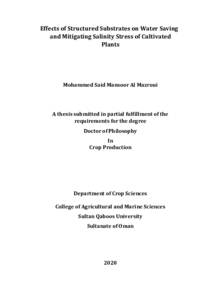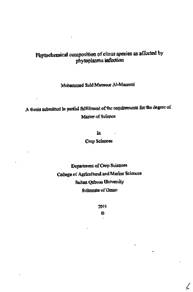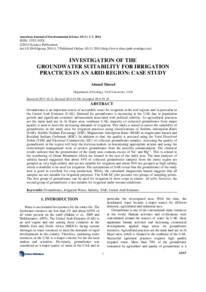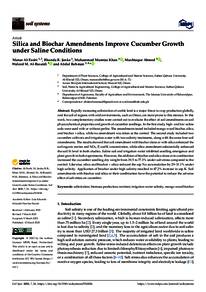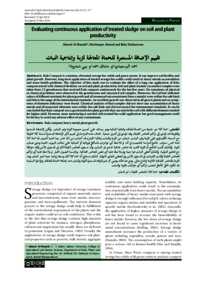Document
Effects of structured substrates on water saving and mitigating salinity stress of cultivated plants.
Identifier
Al-Mazroui, Mohammed Said Mansoor (2020). Effects of structured substrates on water saving and mitigating salinity stress of cultivated plants (Doctoral dissertation, Sultan Qaboos University, Muscat, Oman).
Publisher
Sultan Qaboos University.
Gregorian
2020
Language
English
English abstract
Salinity and water scarcity are the major abiotic factors limiting agricultural
production in the world, particularly in arid and semi-arid regions like Oman.
Capillary barrier (CB) is one of the potential techniques which can mitigate both
the salinity and water scarcity problems. CB is a composition of two soil layers
having distinct differences in textural and, therefore, hydraulic characteristics. This
study aimed to investigate the effect of structured substrates (both native soil and
potting media substrates) on plant growth and production, water-saving, and
mitigating salinity problems.
The first part of the study focused on the effect of layered potting media on the
growth and production of marigold. Marigold seedlings were grown in a layered
potting medium as well as in mixed potting media. For each layered media, there
was a mixed medium of the same substrates. Several vegetative, reproductive, and
physiological parameters were measured. Generally, layered media resulted in
better vegetative and reproductive growth of marigold than mixed media.
The second part of the study explored the best layered potting media on mitigating
salinity stress of marigold plants. The best three configurations of layered media in
the previous study were selected to test their effect on mitigating salinity stress of
marigold plants. These configurations were: (Vermiculite-Perlite-Vermiculite),
(Vermiculite-Sand-Vermiculite), and (Vermiculite-Perlite-Peat moss). Each medium
was treated with three salinity levels of irrigation water (ECi= 3 dS m-1, 6 dS m-1and
9 dS m-1) in addition to the control (Desalinated, ECi ≈ 0.6 dS m-1). Several
vegetative, reproductive, and physiological parameters were measured. The results
showed that the presence of sand in the middle layer was more efficient in reducing
salt accumulation in the root zone than perlite, which reflected positively on
marigold growth. Peat moss was also an efficient substrate in reducing salt buildup. However, marigold roots could not penetrate the peat moss substrate due to
the acidity property of the peat moss. Marigold is very sensitive to pH changes.
Overall, layered (Vermiculite-Sand-Vermiculite) medium was the best for growing
marigold under salinity stress.
The third part of the study focused on the unique naturally formed CB discovered
in the reservoir bed of the Al-Khoud dam, Oman. This naturally formed CB
structure in the soil (sediments) resulted in capturing large quantities of water
during reservoir ponding. The infiltrated water has been preserved by capillarity in
the cascade of silty blocks at a depth of 0.5 to 2.5 m, such that wild plants were able
to utilize this in-block moisture, despite prolonged periods of drought and high
VI
temperature. This study aimed to replicate and test the impact of this unique CB on
mitigating the salinity stress of marigold plants grown under an open field
condition. Seedlings of marigold plants were selected as a model-plant and grown
in both structured and unstructured soil. The plants were subjected to three
salinity levels of irrigation water (ECi= 3 dS m-1, 6 dS m-1, and 9 dS m-1) in addition
to the control (Desalinated, ECi ≈ 0.6 dS m-1). Several physiological, vegetative, and
reproductive growth parameters were measured in each treatment. The results
showed that the structured soil significantly improved all plant parameters
measured and helped in reducing the effects of salinity stress on the growth and
production of the marigold under arid-climate field conditions. The results also
showed the capability of structured soil in water-saving and improving water use
efficiency (WUE).
The fourth part of the study focused on investigating the effect of the naturally
formed CB on mitigating salinity problem of tomato plants. The plants were
subjected to three salinity treatments (ECi= 3 dS m-1, 6 dS m-1, and 9 dS m-1) in
addition to control (Desalinated, ECi ≈ 0.6 dS m-1). Several physiological, vegetative,
and reproductive growth parameters were measured in each treatment. The
results showed that growing tomato in the structured soil required less water for
irrigation. The results showed that most vegetative, reproductive, and physiological
parameters of tomato grown in the unstructured soil were negatively affected as
salinity level increased. There was no significant reduction in most vegetative,
reproductive, and physiological parameters of tomato grown in the structured soil.
This study suggests that artificial substrate and soil structuring can be used to save
irrigation water, ameliorate salinity stress and improve plant growth. Further
research for extended period of time is needed to evaluate the long-term impact of
structured media on crop growth and yield and the economics of crop cultivation.
Member of
Resource URL
Arabic abstract
تعد الملوحة وندرة المياه من أهم العوامل البيئية التي تحد من الانتاج الزراعي في العالم وخاصة في المناطق الجافة وشبه الجافة. يعتبر استخدام الحاجز الشاعر هاو أحد الاساسيات المحتملة التي يمكن أن تخفف من حدة مشاكل الملوحة وندرة المياه. الحاجز الشعري عبارة عن طبقتين او أكثر من طبقات التربة تتباين فيما بينها في قوام التربة وبالتالي في الخصائص الهيدرولوجياة. فاي هاهه االطروحة تمت دراسة تأثير الحاجز الشاعر )فاي الترباة االصالية ووساائط النماو المساتخدمة فاي اسصص( على نمو النبات وإنتاجه وكهلك على توفير المياه والتخفيف من مشكلة الملوحة. ركز الجزء اسول من الدراسة على تأثير وسائط النمو المكونة مان طبقاات علاى نماو وإنتااج نباات الماريجولد. تم زراعة الماريجولد في وسائط نمو هات طبقات وكهلك في وسائط نمو مختلطة. لكل من الوسائط هات الطبقات كان هنااك وساط نماو مخاتلط مان نفا المكوناات. تام قياا العدياد مان معايير النمو الخضرية والانتاجياة والفسايولوجية. بشاكل عاام اوضاحت النتاائ باأن وساائط النماو هات الطبقات كانت أفضل في نمو وانتاج أزهار الماريجولد عن وسائط النمو المختلطة. أما الجزء الثاني من االطروحاة فتركزت على دراسة مدد قدرة وسائط النمو هات الطبقات في التخفيف من الإجهاد الملحي لنبات الماريجولد. حيث تم اختيار أفضل ثالث تركيبات للوساائط هات الطبقات في الدراسة السابقة )الجزء الأول من االطروحاة( الختباار تأثيرهاا علاى تخفياف اإلجهااد الملحاااي لنباااات الماريجولاااد. التركيباااات التاااي تااام اساااتخدامها هاااي )الفيرميكوليااات - الرمااال - الفيرميكولياات( و)الفيرميكولياات - البيرالياات - الفيرميكولياات( و)الفيرميكولياات - البيرالياات - و dS 6 1 -البيتمو ( وتمت معاملة كل وسط بثالثاة مساتويات ملوحاة مان مياه الار ) m dS 3 m-1 9 dS m و (. تام قياا العدياد 1 ) -بالاضافة إلى الشااهد )المياه المالحة m dS 6.0 ≈ EC 1- من معايير النمو الخضرية والانتاجية والفسيولوجية. أوضحت نتائج الدراسة الاى ان وجاود الرمال في الطبقة الوسطى كان أكثر فعالية من البيراليت في الحد من تراكم الملح في منطقاة الجاهر الاه انعك إيجابيا على نمو نبات الماريجولد. وعلى الرغم من أن البيتماو كانات أي ًضاا ركيزة فعالة في الحد من تراكم المالح إلىأن جهور الماريجولد لام تاتمكن مان النماو فيها أبًدا. قاد يكون هلاك راجع الى خاصية الحموضة المرتفعة للبيتمو . حيث تعتبر الماريجولاد حساسة للغاية لتغيرات درجة الحموضة. بشكل عام كان الوسط )الفيرميكوليات - الرمال - الفيرميكوليات( اسفضال لنماو الماريجولاد تحات تاأثير اإلجهااد الملحاي ويليهاا )الفيرميكوليات - البيراليات - الفيرميكوليات( ثام )الفيرميكوليت - البيراليت - البيتمو (. الجزء الثالث من الدراسة ركز على تأثير الحااجز الشاعر الفرياد المتشاكل طبيعيا والاه اكتشاف فاي ساد الخاوق الواقاع فاي والياة السايا بمحافظة مسقط شمال سلطنة عمان. لقاد وجاد ان هاها الحاجز الشعر الفريد له القدرة على استيعاا كميات كبيرة من الماء في فتارة االمطاار القصايرة واالحتفااظ بهاا علاى عماق يتاراوح مان 0.0 إلاى 0.5 م على الرغم من فترات الجفاف الطويلة ودرجة الحرارة العالية. هادفت هاهه الدراساة إلاى محاكااة هاها الحااجز الفرياد واختباار تاأثيره علاى VIII تخفيف اإلجهاد الملحي لنبات الماريجولد. وتم معاملة النباتاتبمساتويات ملوحاة مختلفاة مان مياه 3 dS m ( الر- 1 6 dS m و -1 9 dS m و ( بالاضافة إلى الشاهد )المياه المالحة 6.0 ≈ EC 1- (. وتام قياا العدياد مان معاايير النماو الخضار والنتائج ومعاايير فسايولوجية للنباتاات. 1-m dS أظهرت النتائج أن التربة المركبة حسنت بشكل كبير جمياع العوامال النباتياة المقاساة وسااعدت فاي الحد مان ثثاار اإلجهااد الملحاي علاى نماو وإنتااج الماريجولاد. وأظهارت النتاائ أيضاا قادرة الترباة المركبة في توفير المياه ورفع من كفاءة استخدام المياه (WUE. ( ركاز الجازء الراباع مان االطروحاة علاى دراساة تاأثير الحااجز الشاعر المتشاكل طبيعياا فاي ساد الخوق على تخفيف مشكلة االجهاد الملحي لنبات الطماطم. تم معاملة النباتاتبمساتويات ملوحاة 3 dS m ( الار مياه مان مختلفاة- 1 6 dS m و -1 9 dS m و ( باإلضاافة إلاى الشااهد )المياه 1- (. وتام قياا العدياد مان معاايير النماو الخضار والنتائج ومعاايير 1 -المالحة m dS 6.0 ≈ EC فسايولوجية للنباتااات وكاهلك معااايير بيوكميائيااة للثماار. أوضااحت الدراسااة تاأثر نباتااات الطماااطم المزروعة في التربة الغير مهيكلة بشكل كبير بزيادة مستود االجهاد الملحاي. شامل تاأثير االجهااد الملحاي علاى النماو الخضار وعلاى النتائج وكاهلك علاى معاايير فسايولوجية للنباات وبيوكميائياة للثمار بينما لم يكن هناك تأثير كبيار فاي معظام معاايير النماو الخضارية والانتاجياة والفسايولوجية والبيوكميائية لنبات الطماطم التي زرعت في التربة المركبة. أشاارت النتاائ ايضاا الاى ان زراعاة الطماطم في التربة المركبة أدد الى انخفاق كمية المياه المستخدمة في الار مماا يأكاد قادرة هاهه التركيبة الفريدة من التربة المركبة في توفير المياه ورفع من كفاءة استخدام المياه (WUE. ( تشير ههه الدراسة الى ان وسائط النمو هات الطبقات و التربة المركبة ممكن ان تحاافظ علاى مياه الر والحد والتخفيف من االجهاد الملحي وتحسين نمو النبات. هنااك حاجاة الاى مزياد مان البحاث لتقييم تأثير هيكلة وسائط النمو والتربة على نمو النباتات والانتاج على المدد البعيد وتقييم الجدود االقتصادية من استخدامها في زراعة المحاصيل.
Category
Theses and Dissertations

